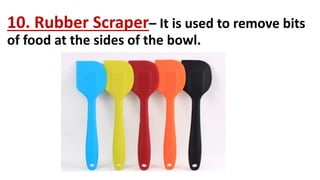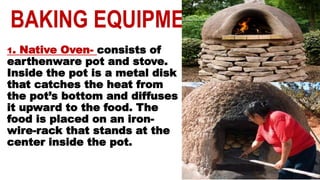Baking Tools and Equipment
- 1. UNIT I BREAD AND PASTRY PRODUCTION LESSON 1 BAKING TOOLS AND EQUIPMENT
- 2. BAKING •Refers to cooking in dry heat, especially in an oven, where the temperature is uniform as hot air circulates to cook cake, pie, cookie or bread.
- 3. 1. For Measuring and/or Weighing 1. Set of Measuring Cups - for measuring dry ingredients; made of aluminum , stainless steel or plastic. 1/8 cup to 2 cup sizes
- 4. 2. Set of Measuring Spoons – made of metal or plastic, it is uses to measure small quantities of liquid and dry ingredients. 1/8 teaspoon to 1 tablespoon sizes
- 5. 3. Graduated Measuring Cups – for measuring liquid ingredients. 1 cup to 8 cups sizes
- 6. 4. Dietetic Scale – this is used in measuring ingredients in small quantity, it requires measurements in grams rather than kilos.
- 7. 5. Weighing Scale – used to weigh food such as flour and sugar in large quantities.
- 8. 6. Thermometer/Timer– used to identify the temperature needed for baking.
- 9. 2. FOR CUTTING, MIXING, AND BLENDING
- 10. 2. For Cutting, Mixing and Blending 1. Grater– used for grating cheese and other food.
- 11. 2. Dough Cutter– used to scrape and cut bread dough.
- 12. 3. Pastry Blender– used to mix a hard solid fat into flour in order to make pastries.
- 13. 4. Hand Mixer– it is handed mixing and blending tool that has removable metal beaters and variable speeds.
- 14. 5. Electric Mixer– it is a kitchen appliance used to beat, mix or whip beater.
- 15. 6. Mixing Machine – a more powerful stand mixer machine.
- 16. 7. Flour Sifter – a container in which flour is sifted.
- 17. 8. Rolling Pin – a long round cylinder used to roll out dough or crush cracker crumbs.
- 18. 9. Whisk Beater – It is used to blend ingredients smooth or to incorporate air into mixture, in a process known as whisking or whipping.
- 19. 10. Rubber Scraper– It is used to remove bits of food at the sides of the bowl.
- 20. 11. Wooden Spoon – used for stirring sauces and for mixing ingredients in cooking and made up of wood.
- 21. 12.Kitchen Shears – this utensil is made with a plastic or rubber-coated handle which is often textured allowing for ease of cutting and gripping.
- 22. 13. Cookie Cutter – a device with sharp edges for cutting cookie dough into a particular shape.
- 23. 14. Mixing Bowls – these are used to hold ingredients you are mixing, beating or whipping.
- 24. 15. Mixing Spoons – these are used in food preparation to measure , mix, stir, and toss ingredients.
- 25. 16. Chopping Board – a wooden or plastic board on which food (meats and vegetables) are cut.
- 26. KNIVES: 1. PARING KNIFE •This small knife can be used for peeling and trimming, cutting, and turning, garnishes and creative work, including fruit and vegetable carving.
- 27. 2. SERRATED KNIFE •It is ideal for cutting bread and fruit.
- 28. 3. KITCHEN KNIFE •Used in general food preparation.
- 29. 4. CLEAVER KNIFE • a large, usually rectangular knife, with a very heavy, thick blade which narrow to a sharp edge. It is primarily used for splitting or “cleaving” meat and bone.
- 30. 3. FOR BAKING AND COOKING
- 31. BAKING PANS 1. Loaf pan - It is used to bake loaf bread. 2. Jelly Roll Pan- This is a very shallow, rectangular pan used to bake thin cakes or bars.
- 32. 3. RECTANGULAR PAN- This is a flat metal pan used for baking bread rolls, pastries, and flat cookies, sheet cakes, bars. Swiss rolls and pizzas. 4. ROUND PAN- It is used to bake cakes and pizzas.
- 33. 5. SQUARE PAN- This ideal for sheet cakes, gingerbread, and brownies, and can also be used as a small roasting pan. 6. TUBE-CENTER PAN- This is a round pan with a hollow projection in the middle, used for baking or molding food in the shape of a ring.
- 34. 7. MUFFIN PAN- This is used for muffins and cupcakes. 8. PIE PAN- This is shallow metal dish with sloping sides for holding and shaping dough and filling of a pie, in which pies are baked.
- 35. 9. COOKIE SHEETS- Are baking sheets that have one raised edge. 10. GRIDDLE PAN- Have raised that emulate the searing marks left on the food by an outdoor grill.
- 36. 11. BUNDT PAN – A tube- shaped baking pan with a decorative indented curvature on the bottom of the pan that make a design on the top of the cake when it is unmolded. 12. CUSTARD PAN- A round or oblong pan used to bake custard recipes.
- 37. COOKING GADGETS/WARE 1.OVENPROOF GLASSWARE 2.SAUCEPAN 3.CASSEROLE 4.FRYING PAN 5.DOUBLE BROILER 6.STEAMER
- 38. BAKING EQUIPMENT 1. Native Oven- consists of earthenware pot and stove. Inside the pot is a metal disk that catches the heat from the pot’s bottom and diffuses it upward to the food. The food is placed on an iron- wire-rack that stands at the center inside the pot.
- 39. 2. Portable Oven – has a glass door that allows one to see the cooking inside and a thermostat near the door that regulate the temperature. Heating is done by simply putting the oven on the top of an electric or gas stove.
- 40. 3. Oven in Electric/Gas Range – this is the oven component of a gas/electric range below the top of the stove.
- 41. 4. Deck Oven – baked products are placed on sheet pans or directly on the floor of the oven. Products may be stacked on top of one another.
- 42. 5. Rack Oven – a large oven consisting of a number of racks where sheets are placed.
- 43. 6. Mechanical Oven – an oven with a mechanism that rotates inside so that baked products are in one motion as they are being baked.
- 44. 7. Convection Oven – baked products are cooked from heated air that circulates in the interior of the oven. A turbo broiler operates in the same principle.
- 45. 8. Dutch Oven – a cooking pot with a tight fitting cover. It usually made of thick cast iron and is used for cooking.
- 46. Other Tools and Equipment: 1.Pastry bag 7. Cookie press 2.Cake decorator 8. Ring mold 3.Icing bag 9. Pastry cloth 4.Spatula 10. Cooking press 5.Cooling rack 6.Utility trays
- 47. 1. Pastry bag 2. Cake decorator 3. Icing bag 4. Spatula 5. Cooling rack 6. Utility trays
- 48. 7. Cookie press 8. Ring mold 9. Pastry cloth 6. Cooking press
- 49. CLASSIFICATION OF BAKING TOOLS AND EQUIPMENT 1. BASICS- these are primary tools that are needed for a start on baking lessons. Examples: Graduated Measuring cup mixing bowls Individual Measuring Cup knives Set of measuring spoons forks Mixing Bowls sifter
- 50. 2. CONVENIENCE- these are tools which facilitate the baking process. Examples: Spatula Kitchen Shears Pastry Cloth Grater French Knife electric mixer
- 51. 3. SPECIALIZED- these are tools and equipment used for special recipes or for special purposes. Examples: Tube center pan Griddles Waffle baker
- 52. KINDS OF OVEN 1.KEROSENE OVEN 2.CHARCOAL OVEN 3.TIN OVEN 4.PORTABLE GLASS FRONT 5.GAS OR ELECTRIC RANGE
- 53. 6. WONDER OVEN 7. TURBO BROILER
- 54. HOW TO TAKE CARE OF BAKING TOOLS AND EQUIPMENT?
- 55. Sample inventory of baking tools and equipment QUANTITY DESCRIPTION GOOD NEEDS REPAIR NEEDS REPLACEMENT TO BE CONDEMNED 1 Portable electric mixer - Brand: Imarflex 1 Microwave Oven - Brand : Standard
- 56. Proper storage of tools and equipment
- 57. TYPES AND USES OF CLEANSING MATERIALS/DISINFECTANTS
- 58. 1. Borax or washing soda •Disinfects and removes stains and odors •Can kill molds and mildew
- 59. 2. Baking soda •Disinfects and removes stains and odors.
- 60. 3. Liquid detergent/bar soap •Removes grease, grimes, and dirt in pots, pans and kitchen tools and equipment.
- 61. 4. cleanser •Used for scrubbing surfaces with stubborn dirt and acts as an abrasive cleaner.
- 62. 5. sponge •Removes food debris in plates, pots, pans, and other kitchenware •Does not scratch the surface
- 63. 6. Scrubbing pad •Comes in different sizes and textures.
- 64. 7. vinegar •It is a disinfectant and deodorizer, used for cleaning microwave oven and other appliances.
- 65. 8. Lemon juice •It can be mixed with baking soda to form a cleaning paste for pots and pans and kitchenware.
- 66. 9. Sodium hypochlorite •Commonly known as “CLOROX”. •It is commonly used for cleaning, disinfecting and bleaching clothes, linens and towels.
- 67. REFLECT 1. How is familiarity with baking tools and equipment related to success in baking? 2. What will happen


































































